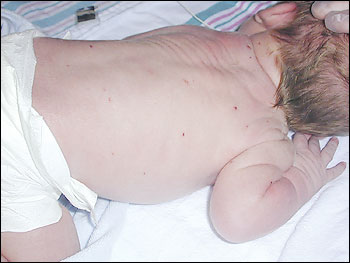A 1-day-old girl with scattered erosions
Click Here to Manage Email Alerts
You are seeing newborn infants in the nursery today.
The first patient is a 1-day-old full-term, appropriate for gestational age girl born to a healthy 26-year-old, G1P0 mother. There were no complications with the pregnancy or delivery, however, the mother expresses concern to you regarding a rash she states developed within several hours of birth.
The infant is well-appearing and in no acute distress. The skin examination reveals multiple scattered erosions, vesicles and crusted papules with surrounding erythema ranging from 3 mm to 6 mm in diameter on the face, trunk and extremities. The rest of the exam is unremarkable. You think first of possible infections.
Upon further review of the mother’s past medical history, you note that she is negative for group B Streptococcus and all sexually transmitted diseases including herpes simplex virus and HIV. There is no history of fever or other recent illness. A septic workup and herpes simplex virus polymerase chain reaction of a skin lesion and colony-stimulating factor are negative. What is your diagnosis?

Did you manage to spot the rash? Click to the next page to find out.
Answer
Congenital self-healing reticulohistiocytosis is a disorder of Langerhans cells seen at birth or shortly thereafter. It is also known as congenital Langerhans cell histiocytosis or Hashimoto-Pritzker disease.
In a retrospective review by Minkov et al, the incidence of neonatal CSHR obtained from the population-based German Childhood Cancer Registry was one to two per 1 million. The lesions that typically appear at birth or in the first several weeks of life are usually confined to the skin but can be disseminated. In most cases, skin lesions spontaneously involute by age 4 months.
The varying morphology of the skin lesions makes this diagnosis challenging. Lesions may be single or multiple and include erythematous erosions, papules, pustules, vesicles, nodules, petechiae, crusting, milia and atrophy. CSHR can mimic many other newborn eruptions and the differential diagnosis is extensive. Other benign neonatal conditions to consider include erythema toxicum neonatorum, transient neonatal pustular melanosis, miliaria pustulosa, and acropustulosis of infancy. Infectious etiologies to include in the differential include viral infections such as herpes, varicella and cytomegalovirus. Bacterial infections to consider include Staphylococcal and Streptococcal species, Haemophilus influenza, syphilis and Listeria, as well as fungal and parasitic infections. Bullous disorders seen at birth may also appear similar and include epidermolysis bullosa, mastocytosis, incontinentia pigmenti and pemphigus vulgaris.
Diagnosis is made by skin biopsy. Tissues stained with hematoxylin-eosin show a large dermal infiltrate of histiocytic cells with reniform nuclei. Electron microscopy demonstrates the pathognomic Birbeck granules within the histiocytes. Immunohistochemical staining is positive for S-100 and/or CD1a in CSHR.

A workup must be obtained in any patient diagnosed with CSHR to rule out disseminated disease. Other organs affected include the lungs, liver, spleen, bone, GI tract, central nervous system, lymphatic and hematopoietic systems. Pituitary infiltration can result in diabetes insipidus or growth hormone deficiency. Recommended workup based on guidelines from the Histiocyte Society includes a complete blood count, liver function tests, coagulation studies, skeletal surveys, a chest radiograph and a urine osmolarity. Computed tomography or magnetic resonance imaging of the abdomen and brain are useful if there are concerns on exam or suggestive abnormal laboratory results.
Management and prognosis are based on the extent of disease. If it is confined to skin, observation alone is appropriate. If disseminated disease is discovered, treatment includes prednisone and vinblastine with or without methotrexate for six to 12 months. The prognosis of cutaneous CSHR is excellent, but there is a chance that it can still evolve into disseminated disease, especially diabetes insipidus, later in life after the skin lesions have cleared. Therefore, it is important to maintain close follow-up; visits are recommended initially every six months and yearly thereafter. Disseminated disease at presentation has a poorer prognosis. The retrospective review by Minkov et al found that survival at 5 years in patients with single system disease was 94%, whereas with multisystem disease it was 57%.
For more information:
- Marissa Perman is at Cincinnati Children’s Hospital Medical Center.
- Avram MM, Gobel V, Sepehr A. Case 30-2007: a newborn girl with skin lesions. N Engl J Med. 2007;357:1327-1335.
- Egeler RM. LCH: The symptoms, diagnosis and treatment. Histiocytosis Association of America website. www.histio.org. Accessed June 26, 2008.
- Minkov M, Prosch H, Steiner M, et al. Langerhans cell histiocytosis in neonates. Pediatr Blood Cancer. 2005;45:802-807.
- Stein SL, Paller AS, Haut PR, Mancini AJ. Langerhans cell histiocytosis presenting in the neonatal period: a retrospective case series. Arch Pediatr Adolesc Med. 2001;155:778-783.
Spot the Rash is a monthly case study featured in Infectious Diseases in Children designed to test your skills in pediatric dermatology issues.
